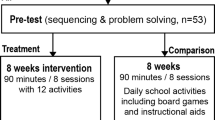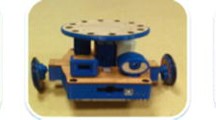Abstract
This paper examines the impact of programming robots on sequencing ability during a 1-week intensive robotics workshop at an early childhood STEM magnet school in the Harlem area of New York City. Children participated in computer programming activities using a developmentally appropriate tangible programming language CHERP, specifically designed to program a robot’s behaviors. The study assessed 27 participants’ sequencing skills before and after the programming and robotics curricular intervention using a picture-story sequencing task and compared those skills to a control group. Pre-test and post-test scores were compared using a paired sample t test. The group of children who participated in the 1-week robotics and programming workshop experienced significant increases in post-test compared to pre-test sequencing scores.


Similar content being viewed by others
Notes
Based on prior studies, we predicted the direction of the results and, therefore, used a one-tailed significance value.
References
American Library Association (ALA). (2000). Information literacy competency standards for higher education. Chicago, IL: The Association of College and Research Libraries. Retrieved from: http://www.ala.org/acrl/sites/ala.org.acrl/files/content/standards/standards.pdf.
Baron-Cohen, S., Leslie, A. M., & Frith, U. (1986). Mechanical, behavioural and Intentional understanding of picture stories in autistic children. British Journal of Developmental Psychology, 4, 113–125.
Barron, B., Cayton-Hodges, G., Bofferding, L., Copple, C., Darling-Hammond, L., & Levine, M. (2011). Take a giant step: A blueprint for teaching children in a digital age. New York, NY: The Joan Ganz Cooney Center at Sesame Workshop.
Bers, M. (2008). Blocks to robots: Learning with technology in the early childhood classroom. New York, NY: Teacher’s College Press.
Bers, M. U. (2010). The TangibleK robotics program: Applied computational thinking for young children. Early Childhood Research & Practice, 12(2). Retrieved from http://ecrp.uiuc.edu/v12n2/bers.html.
Bers, M., & Horn, M. (2010). Tangible programming in early childhood: Revisiting developmental assumptions through new technologies. In I. Berson & M. Berson (Eds.), High-tech tots: Childhood in a digital world (pp. 49–70). Charlotte, NC: Information Age Publishing.
Bers, M. U., Ponte, I., Juelich, K., Viera, A., & Schenker, J. (2002). Teachers as designers: Integrating robotics into early childhood education. Information Technology in Childhood Education Annual, 14, 123–145.
Brennan, K., Monroy-Hernandez, A., & Resnick, M. (2010). Making projects, making friends: Online community as catalyst for interactive media creation. New Directions for Youth Development, 128, 75–83.
Brosterman, N. (1997). Inventing kindergarten. New York, NY: H.N. Abrams.
Brown, A. L., & French, L. A. (1976). Construction and regeneration of logical sequences using causes or consequences as the point of departure. Child Development, 47(4), 930–940.
Brown, A. L., & Murphy, M. D. (1975). Reconstruction of arbitrary versus logical sequences by preschool children. Journal of Experimental Child Psychology, 20, 307–326.
Clements, D. H. (1987). Longitudinal study of the effects of logo programming on cognitive abilities and achievement. Journal of Educational Computing Research, 3, 73–94.
Clements, D. H. (1999). The future of educational computing research: The case of computer programming. Information Technology in Childhood Education Annual, 147–179.
Clements, D. H., Battista, M. T., & Sarama, J. (2001). Logo and geometry. Journal for Research in Mathematics Education Monograph Series, 10.
Cunha, F., & Heckman, J. (2007). The technology of skill formation. American Economic Review, 97(2), 31–47.
Davidson, C. N. (2011). Now you see it: How the brain science of attention will transform the way we live, work, and learn. New York, NY: Viking.
FCC. (2010). National broadband plan. Retrieved from http://www.broadband.gov/download-plan/.
Fivush, R., & Mandler, J. M. (1985). Developmental changes in the understanding of temporal sequence. Child Development, 56(6), 1437–1446.
Gee, J. P. (2008). Getting over the slump: Innovation strategies to promote children’s learning. New York, NY: The Joan Ganz Cooney Center at Sesame Workshop.
Goldstein, I., & Papert, S. (1977). Artificial intelligence, language, and the study of knowledge. Cognitive Science, 1(1), 84–123.
Gutnick, A. L., Robb, M., Takeuchi, L., & Kotler, J. (2010). Always connected: The new digital media habits of young children. New York, NY: The Joan Ganz Cooney Center at Sesame Workshop.
Horn, M. S., Crouser, R. J., & Bers, M. U. (2011). Tangible interaction and learning: The case for a hybrid approach. Personal and Ubiquitous Computing, 16(4), 379–389.
ISTE (International Society for Technology in Education). (2007). NETS for students 2007 profiles. Washington, DC: ISTE. Retrieved from www.iste.org/standards/nets-for-students/nets-for-students-2007-profiles.aspx#PK-2.
Jenkins, H. (2006). Confronting the challenges of participatory culture: Media education for the 21st century. Chicago, IL: The John D. and Catherine T. MacArthur Foundation. Retrieved from http://digitallearning.macfound.
Kazakoff, E. R., & Bers, M. U. (2011). The impact of computer programming on sequencing ability in early childhood. Paper presented at the American Educational Research Association Conference (AERA), Louisiana: New Orleans.
Kazakoff, E. R., & Bers, M. (in press). Programming in a robotics context in the kindergarten classroom: The impact on sequencing skills. Journal of Educational Multimedia and Hypermedia.
Liao, Y.-K., & Bright, G. (1991). Effects of computer-assisted instruction and computer programming on cognitive outcomes: A meta-analysis. Journal of Educational Computing Research, 7(3), 251–268.
Linebarger, D. L., & Piotrowski, J. T. (2009). TV as storyteller: How exposure to television narratives impacts at-risk preschoolers’ story knowledge and narrative skills. British Journal of Developmental Psychology, 27, 47–69.
Madill, H., Campbell, R. G., Cullen, D. M., Armour, M. A., Einsiedel, A. A., Ciccocioppo, A. L., et al. (2007). Developing career commitment in STEM-related fields: myth versus reality. In R. Burke, M. Mattis, & E. Elgar (Eds.), Women and minorities in science, technology, engineering and mathematics: Upping the numbers (pp. 210–244). Northhampton, MA: Edward Elgar Publishing.
Maloney, J., Resnick, M., Rusk, N., Peppler, K. A., & Kafai, Y. B. (2008). Media designs with Scratch: What urban youth can learn about programming in a computer clubhouse. In Proceedings of ICLS’08: The 8th international conference for the learning sciences, vol. 3 (81–82). Utrecht, The Netherlands: International Society of the Learning Sciences.
Markert, L. R. (1996). Gender related to success in science and technology. The Journal of Technology Studies, 22(2), 21–29.
Massachusetts Department of Elementary and Secondary Education (MA DOE). (2008). Kindergarten learning experiences. Malden, MA: Massachusetts Department of Elementary and Secondary Education. Retrieved from http://www.doe.mass.edu/ess/reports/0408kle.pdf.
Meadowcroft, J. M., & Reeves, B. (1989). Influence of story schema development on children’s attention to television. Communication Research, 16(3), 352–374.
Metz, S. S. (2007). Attracting the engineering of 2020 today. In R. Burke, M. Mattis, & E. Elgar (Eds.), Women and minorities in science, technology, engineering and mathematics: Upping the numbers (pp. 184–209). Northampton, MA: Edward Elgar Publishing.
Mioduser, D., & Levy, S. (2010). Making sense by building sense: Kindergarten children’s construction and understanding of adaptive robot behaviors. International Journal of Computers for Mathematical Learning, 15(2), 99–127.
Mioduser, D., Levy, S., & Talis, V. (2009). Episodes to scripts to rules: Concrete-abstractions in kindergarten children’s explanations of a robot’s behaviors. International Journal of Technology and Design Education, 19(1), 15–36.
National Association for the Education of Young Children (NAEYC) & Fred Rogers Center. (2012). Technology and interactive media as tools in early childhood programs serving children from birth through age 8. Retrieved from http://www.naeyc.org/files/naeyc/file/positions/PS_technology_WEB2.pdf.
Nickerson, R. S. (1982). Computer programming as a vehicle for teaching thinking skills. Thinking: The Journal of Philosophy for Children, 4, 42–48.
O’Connell, B. G., & Gerard, A. B. (1985). Scripts & scraps: The development of sequential understanding. Child Development, 56(3), 671–681.
Papert, S. (1980). Mindstorms: Children, computers, and powerful ideas. New York, NY: Basic Books.
Paris, A. H., & Paris, S. G. (2003). Assessing narrative comprehension in young children. Reading Research Quarterly, 38(1), 36–76.
Pea, R. D., & Kurland, D. M. (1984). On the cognitive effects of learning computer programming. New Ideas in Psychology, 2, 137–168.
Piaget, J. (1969). The child’s conception of time. London, England: Routledge & Kegan Paul.
Piaget, J. (1970). Science of education and the psychology of the child. New York, NY: Orion Press.
Resnick, M. (2006). Computer as paintbrush: Technology, play, and the creative society. In D. Singer, R. Golikoff, & K. Hirsh-Pasek (Eds.), Play = learning: How play motivates and enhances children’s cognitive and social-emotional growth. New York, NY: Oxford University Press.
Resnick, M., Flanagan, M., Kelleher, C., MacLaurin, M., Ohsima, Y., Perlin, K., Torres, R. (2009a). Growing up programming: Democratizing the creation of dynamic interactive media. In Proceedings of the CHI (Computer-Human Interaction) 2009 conference. Boston, Massachusetts. Retrieved from http://web.media.mit.edu/~mres/papers/CHI-programming-panel.pdf.
Resnick, M., Maloney, J., Monroy-Hernandez, A., Rusk, N., Eastmond, E., Brennan, K., et al. (2009b). Scratch: Programming for all. Communications of the ACM, 52(11), 60–67.
Reynolds, A. J., Temple, J. A., Ou, S. R., Arteaga, I. A., & White, B. A. B. (2011). School-based early childhood education and age-28 well-being: Effects by timing, dosage, and subgroups. Science, 333(6040), 360–364.
Rogers, C., & Portsmore, M. (2004). Bringing engineering to elementary school. Journal of STEM Education, 5(3–4), 14–28.
Rushkoff, D. (2010). Program or be programmed: Ten commands for a digital age. New York, NY: O/R Books.
Sarama, J., & Clements, D. H. (2003). Building blocks of early childhood mathematics. Teaching Children Mathematics, 9(8), 480–484.
Snow, C. E., Tabors, P. O., Nicholson, P., & Kurland, B. (1994). SHELL: Oral language and early literacy skills in kindergarten and first grade children. Journal of Research in Childhood Education, 10, 37–48.
Steele, C. M. (1997). A threat in the air: How stereotypes shape intellectual identity and performance. American Psychologist, 52, 613–629.
Takanishi, R. (2010). PreK-third grade: A paradigm shift. In J. Andrews & V. Washington (Eds.), Children of 2020: Creating a better tomorrow (pp. 28–31). Washington, DC: Council for Professional Recognition.
Thoman, E., & Jolls, T. (2003). Literacy for the 21st century: An overview & orientation guide to media literacy education. Malibu, CA: Center for Media Literacy. Retrieved from: http://www.medialit.org/sites/default/files/mlk/01_MLKorientation.pdf.
U.S. Department of Education. (2010a). Educate to innovate. Retrieved from http://www.whitehouse.gov/issues/education/educate-innovate.
U.S. Department of Education. (2010b). Transforming American education: Learning powered by technology. Retrieved from: http://www.ed.gov/technology/netp-2010.
U.S. Department of Education, National Center for Education Statistics. (2001). Entering kindergarten: Findings from the condition of education 2000. Washington, DC: U.S. Government Printing Office. Retrieved from http://nces.ed.gov/pubs2001/2001035.pdf.
Zelazo, P. D., Carter, A., Reznick, J. S., & Frye, D. (1997). Early development of executive function: A problem-solving framework. Review of General Psychology, 1(2), 198–226.
Acknowledgments
This research was funded by the National Science Foundation (NSF Grant DRL-0735657). Any opinions, findings, and conclusions or recommendations expressed in this article are those of the authors and do not necessarily reflect the views of the National Science Foundation. The authors would like to thank the DevTech Research Group, participating school, teachers, and children, and members of Tufts Spring 2012 CD143 course.
Author information
Authors and Affiliations
Corresponding author
Appendix A: Sample Sequencing Cards
Appendix A: Sample Sequencing Cards
Rights and permissions
About this article
Cite this article
Kazakoff, E.R., Sullivan, A. & Bers, M.U. The Effect of a Classroom-Based Intensive Robotics and Programming Workshop on Sequencing Ability in Early Childhood. Early Childhood Educ J 41, 245–255 (2013). https://doi.org/10.1007/s10643-012-0554-5
Published:
Issue Date:
DOI: https://doi.org/10.1007/s10643-012-0554-5






